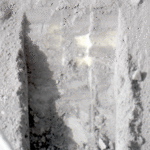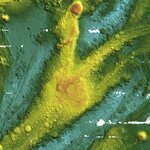Geology

The movements in the liquid part of the Earth’s core are changing surprisingly quickly, and this affects the Earth’s magnetic field, according to new research from DTU Space.
The Ørsted satellite’s very precise measurements of the Earth’s magnetic field over the past nine years have made it possible for Nils Olsen, Senior Scientist with DTU Space, and several German scientists, to map surprisingly rapid changes in the movements in the Earth’s core. The results have just been published in the scientific journal Nature Geoscience.
“What is so surprising is that rapid, almost sudden, changes…

Dice-size crumbs of bright material have vanished from inside a trench where they were photographed by NASA's Phoenix Mars Lander four days ago, convincing scientists that the material was frozen water that vaporized after digging exposed it.
"It must be ice," said Phoenix Principal Investigator Peter Smith of the University of Arizona, Tucson. "These little clumps completely disappearing over the course of a few days, that is perfect evidence that it's ice. There had been some question whether the bright material was salt. Salt can't do that."
The chunks were left at the bottom of a trench…

Information gleaned from a Greenland ice core by an international science team shows that two huge Northern Hemisphere temperature spikes prior to the close of the last ice age some 11,500 years ago were tied to fundamental shifts in atmospheric circulation.
The ice core showed the Northern Hemisphere briefly emerged from the last ice age some 14,700 years ago with a 22-degree-Fahrenheit spike in just 50 years, then plunged back into icy conditions before abruptly warming again about 11,700 years ago. Startlingly, the Greenland ice core evidence showed that a massive "reorganization" of…

Several huge active submarine volcanoes, spreading ridges and rift zones have been discovered northeast of Fiji by a team of Australian and American scientists aboard the Marine National Facility Research Vessel, Southern Surveyor.
On the hunt for subsea volcanic and hot-spring activity, the team of geologists located the volcanoes while mapping previously uncharted areas. Using high-tech multi-beam sonar mapping equipment, digital images of the seafloor revealed the formerly unknown features.
The summits of two of the volcanoes, named 'Dugong', and 'Lobster', are dominated by large calderas…

Residents of the central and southern Midwest are crossing their fingers, saying their prayers, planning evacuations, and in some cases filling sandbags in preparation for the excessive water ravishing communities in Iowa and Wisconsin.
"The flood wave is propagating down the Mississippi River towards St. Louis at about the pace of a brisk walk," said Robert E. Criss, Ph.D., professor of earth and planetary sciences in Arts & Sciences at Washington University in St. Louis. "Some areas north of St. Louis in Missouri and southern Iowa are bracing for the second worst flood in their history…

If you are curious about Earth's periodic mass extinction events such as the sudden demise of the dinosaurs 65 million years ago, you might consider crashing asteroids and sky-darkening super volcanoes as culprits.
But a new study suggests that it is the ocean, and in particular the epic ebbs and flows of sea level and sediment over the course of geologic time, that is the primary cause of the world's periodic mass extinctions during the past 500 million years.[1]
"The expansions and contractions of those environments have pretty profound effects on life on Earth," says Shanan Peters, a…

New fossil evidence from the rock desert and cold, treeless steppes of Tibet's desolate Himalayan-Tibetan Plateau that now comprise Earth's highest land mass suggests a literally groundbreaking possibility:
Major tectonic changes on the Tibetan Plateau may have caused it to attain its towering present-day elevations -- rendering it inhospitable to the plants and animals that once thrived there -- as recently as 2-3 million years ago, not millions of years earlier than that, as geologists have generally believed. The new evidence calls into question the validity of methods commonly used by…

The two-year old mud volcano called Lusi spews huge volumes of mud and has displaced more than 30,000 people and caused millions of dollars worth of damage. An international team of scientists has now concluded that it was caused by the drilling of a gas exploration well and not by an earthquake that happened two-days before the mud volcano erupted in East Java, Indonesia.
The report by British, American and Indonesian and Australian scientists outlines and analyzes a detailed record of operational incidents on the drilling of a gas exploration well, Banjar-Panji-1. (A)
Lead author Prof.…

A seismologist at Washington University in St. Louis and colleagues at Pennsylvania State University and Newcastle University in the United Kingdom have found seismic signals from a giant river of ice in Antarctica that makes California's earthquake problem seem trivial.
Douglas A. Wiens, Ph.D., Washington University professor of earth and planetary sciences in Arts&Sciences, and colleagues combined seismological and global positioning system (GPS) analyses to reveal two bursts of seismic waves from an ice stream in Antarctica every day - and each one equivalent to a magnitude seven…
Lusi, the world’s fastest-growing mud volcano, is collapsing and could subside to depths of more than 140 meters with consequences for the surrounding environment, according to new research.
As the second anniversary (May 29) of the eruption on the Indonesian island of Java approaches, scientists have also found that the center of the volcano is collapsing by up to three meters overnight.
Such sudden collapses could be the beginning of a caldera - a large basin-shaped volcanic depression - according to the research team, from Durham University UK, and the Institute of Technology Bandung, in…